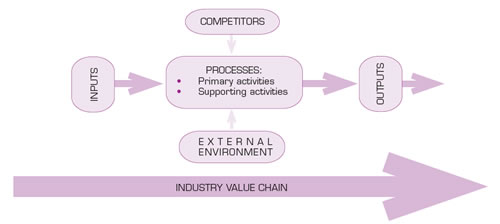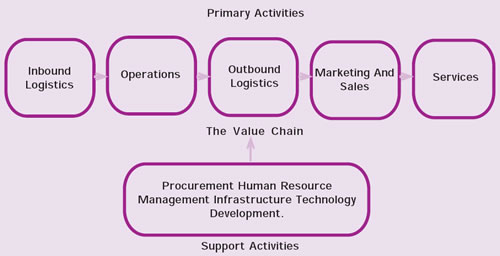*************************************************************************************
Businesses are built around processes that are designed to add value
through the creation of an end product / service that will meet the
needs of customers.The international market offers exciting
opportunities to the small business in terms of growth potential.
These processes require certain inputs, and they result in specific
outputs. The inputs to this process include the raw materials, the
knowledge and the technology that is required to start the process.
The output is a product / service that, if it meets the needs of the
customers sufficiently and better than anyone else does, will create
profits for the business owner and satisfaction for the customers.
The activities that a business conducts in order to create a competitive
advantage in the market place are referred to as the Value Chain.
This consists of a series of value - generating activities your business
undertakes in order to provide a value added end product to your
customers.
A basic understanding of this value chain, i.e.:
INPUTS -> PROCESS -> OUTPUTS
procurement systems that support it, are an important component of
the small business owner’s operational requirements.
If you consider your own business, or your plans to start your own
business, then the stages in the value chain may be represented by the
following simple flow diagram:

THE SUPPLY CHAIN
Definition:
A co-ordinated system of organizations, people, activities,
information and resources involved in moving a product or service in a
physical or virtual manner from supplier to customer.
The supply chain therefore consists of:
-
Manufacturers.
-
Service providers.
-
Distributors.
-
Sales channels e.g. retail outlets.
-
Consumers / end users.
-
Customers.
The supply chain activities transform raw
materials into a finished product that is delivered to the customer.
Supply chain management involves meeting customer needs through the most
efficient use of resources.
THE VALUE CHAIN
Definition:
The Value Chain is each organization's contribution to the supply
chain.
The idea of the value chain is based on the process view of a business,
made up of sub-systems each with inputs, processes and outputs. How
Value Chain activities are carried out determines costs and affects
profits.
Porter's Value Chain

Secondary activities are:
-
Procurement
-
Human Resource management
-
Technological Development
-
Infrastructure
METHODS OF OBTAINING BUSINESS
There are various methods of securing business for your company. You
will need to decide which method/s best suit your product / service. The
various methods are:
-
Tendering
-
Joint Venturing And Sub-contracting
-
Cold Calling
-
Sales Networking
-
Direct Selling
PROCURING GOODS AND SERVICES
Procurement is defined as the acquisition of goods and services at
the best possible cost, in the right quantity and at the right quality,
at the right time, in the right place.
Procurement is the purchasing function of an organisation.In a small
business, the owner would most likely oversee this entire process, but
in the larger businesses an entire department takes care of this
function.
When procuring supplies for your business, consider the following:
-
How much should you buy?
-
When should you buy?
-
How much will it cost?
-
How will the supplies be handled / stored / requisitioned?
-
What are the risks involved?
There are 2 main types of procurement, i.e.:
-
Direct production - related procurement
-
Indirect procurement
* Buy the SME Toolkit for more details about Procurement and Value Chain